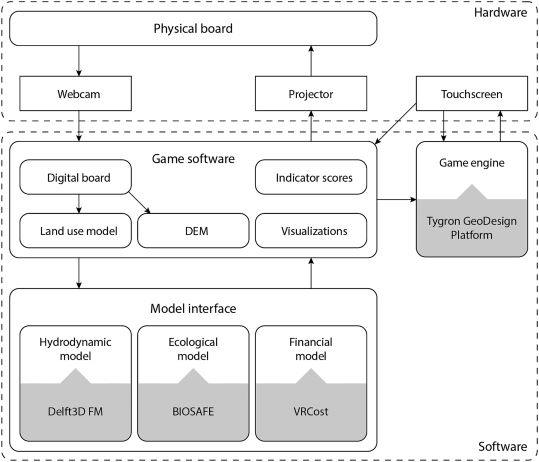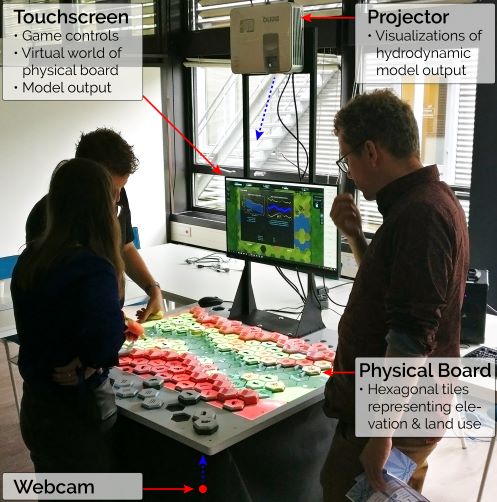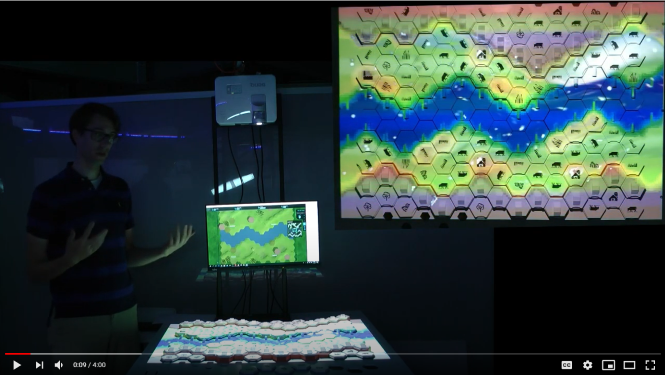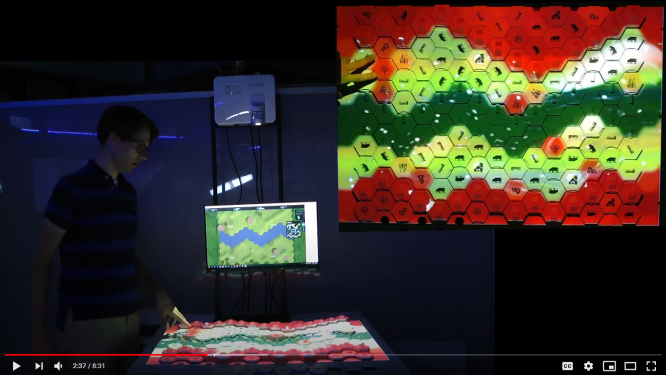Tygron for Scientific Research: Difference between revisions
No edit summary |
|||
| Line 31: | Line 31: | ||
*reflect upon the potential effects of those interventions | *reflect upon the potential effects of those interventions | ||
To do that, the researcher is expected to develop and test a serious virtual game where players experience how river systems function. | To do that, the researcher is expected to: | ||
*develop and test a serious virtual game where players experience how river systems function. | |||
*write a dissertation paper | |||
==Research process== | ==Research process== | ||
The game was developed based on a need-driven approach | |||
Who was involved: | |||
The supervisors were involved - professor in human-centered design + professor in Hydraulic engineering | |||
post-doc involved for discussions during the process | |||
As for the game: Florian + Hansje for the feedback | |||
Practically, connecting the board to the game: Rudolf | |||
Deltares: Fedor Baart (co-author) - coding expertise and modeling expertise | |||
Other researchers | |||
===Time distribution=== | ===Time distribution=== | ||
The research was designed for a 4 year programme, however the researcher did it within 5 years, on a 4-days a week basis, since he was employed by the university 1 day/week. | |||
In this case, the initial research was very time-intensive, taking up to 3 years. This phase included intermediate prototypes. | |||
3 prototypes were formally tested. | |||
The rest (2 years) were the development of the game (prototyping) and testing. | |||
The testing included test sessions with stakeholders. 5 sessions were organized at the end of the research phase, and all took place within 6 weeks. | |||
Afterwards more sessions were organized but unfortunately they stopped due to the covid lockdown. | |||
===Resources=== | ===Resources=== | ||
The researcher did not have experience in GIS or geodesign or coding | |||
Limited programming/coding base + course along the way. | |||
Design methods | |||
Practical side - making the board - CAD laser cutting. | |||
Masters in Industrial Design Engineering (utwente) | |||
The researcher had to learn how to use Tygron | |||
He received some training from the Tygron team. | |||
He visited the Tygron office for 2 full days in the beginning. | |||
Part of it was a discussion about the project: What can and cannot be done with Tygron. | |||
That was followed by a few visits to discuss the links between Tygron and the board game. | |||
The researcher also relied on the web-based form of the API as well as the wiki. | |||
===Using Tygron=== | ===Using Tygron=== | ||
[[File:VirtualGame2.jpg|thumb|250px|right|The Virtual River Game's hardware and software.]] | [[File:VirtualGame2.jpg|thumb|250px|right|The Virtual River Game's hardware and software.]] | ||
| Line 53: | Line 87: | ||
==Feedback and recommendations== | ==Feedback and recommendations== | ||
-The researcher recommends 3rd parties to create added value (what is actually needed) | |||
- Also involving 3rd parties is important for practical expertise and knowledge | |||
==Contact== | ==Contact== | ||
Revision as of 14:53, 11 March 2021
Use-case 4: “the Virtual River Game”
This page of the manual is still under development. The final version will be launched on April 8th 2021 during the EDU event 2021.
A PhD candidate at the University of Twente was assigned to create a serious gaming environment for river interventions as a tool that facilitates stakeholder engagement. The research was one among 20 projects as part of the RiverCare research program. The researcher is a human-centered interface designer, and is not an expert in river interventions. After developing and testing several prototypes, the researcher created the the virtual river game, a unique board-game that is digitally connected to the Tygron platform. To simulate river interventions, players can move the pieces on the board, and immediately see the changes on the Tygron screen including the new map, as well as numerical calculations and graphs.
Content of the Research
General information
- The PhD Position:"A serious gaming environment for river interventions"
- Main Researcher:"Robert-Jan den Haan"
- Research Programme: RiverCare
- Department: Department of Design, Production & Management
- Educational Institute: Faculty of Engineering Technology of the University of Twente
- Involved Organisations: Rijkswaterstaat, Deltares, Witteveen+Bos, Arcadis, HKV, T-Xchange, TWO & Tygron Geodesign Platform
Objectives and desired outcome
The main objective of the research is to create a virtual game that allows players to interact with an imaginary river section.
The game would allow different stakeholder groups to:
- learn about each others' perspectives regarding river management
- take better decisions of river interventions
- reflect upon the potential effects of those interventions
To do that, the researcher is expected to:
- develop and test a serious virtual game where players experience how river systems function.
- write a dissertation paper
Research process
The game was developed based on a need-driven approach Who was involved: The supervisors were involved - professor in human-centered design + professor in Hydraulic engineering post-doc involved for discussions during the process As for the game: Florian + Hansje for the feedback Practically, connecting the board to the game: Rudolf Deltares: Fedor Baart (co-author) - coding expertise and modeling expertise Other researchers
Time distribution
The research was designed for a 4 year programme, however the researcher did it within 5 years, on a 4-days a week basis, since he was employed by the university 1 day/week. In this case, the initial research was very time-intensive, taking up to 3 years. This phase included intermediate prototypes. 3 prototypes were formally tested. The rest (2 years) were the development of the game (prototyping) and testing. The testing included test sessions with stakeholders. 5 sessions were organized at the end of the research phase, and all took place within 6 weeks. Afterwards more sessions were organized but unfortunately they stopped due to the covid lockdown.
Resources
The researcher did not have experience in GIS or geodesign or coding Limited programming/coding base + course along the way. Design methods Practical side - making the board - CAD laser cutting. Masters in Industrial Design Engineering (utwente)
The researcher had to learn how to use Tygron He received some training from the Tygron team. He visited the Tygron office for 2 full days in the beginning. Part of it was a discussion about the project: What can and cannot be done with Tygron. That was followed by a few visits to discuss the links between Tygron and the board game.
The researcher also relied on the web-based form of the API as well as the wiki.
Using Tygron
API (Application Programmers Interface)
Outcome of the research
You can find the full research paper here: The Virtual River Game: Gaming using models to collaboratively explore river management complexity
You can find the summary poster of the project here: File:Summary poster - virtual river game.pdf
Feedback and recommendations
-The researcher recommends 3rd parties to create added value (what is actually needed) - Also involving 3rd parties is important for practical expertise and knowledge
Contact
For more information about this PhD research, you can contact us at: info@Tygron.com
You can also contact Robert-Jan den Haan, researcher at the University of Twente at: r.j.denhaan@utwente.nl
| <<Previous page | Next page>> |




